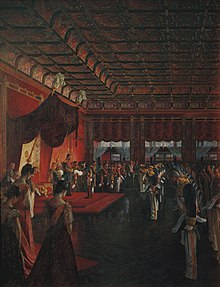Anglo-Japanese Treaty of Commerce and Navigation
[2] The Russian delegation arrived in Nagasaki on 12 August 1853, a month after the Americans, and began a series of negotiations that would lead to the signing of the Treaty of Shimoda with the Tokugawa Shogunate on 7 February 1855.[4]: 429 In August 1855 the Foreign Secretary Lord Clarendon entrusted Sir John Bowring, Governor of Hong Kong, with the task of claiming more significant commercial advantages for Britain in Japan.The war in China ended with the Treaty of Tianjin, signed for Britain by James Bruce, 8th Earl of Elgin, who was responsible for the burning down of the Summer Palace in Beijing.[4][page needed] This stipulated that all British citizens who committed crimes against Japanese subjects or those of any other country were to be judged by consuls or other designated authorities under the laws of Great Britain.In order to renegotiate the terms of previous treaties and better study western culture and technology, a great expedition around the globe was organized, led by Iwakura Tomomi.In England, he held fruitful talks with Lord Granville, British Foreign Secretary, in November 1872, in which Japan was asked to modernize its laws before it could effectively renegotiate treaties and abrogate extraterritoriality.Internationally, all of the imperial government's efforts were concentrated on the abrogation of the so-called 'Unequal Treaties', which were in fact unilateral, non-reciprocal pacts that subscribed to an implicit subservience of the Japanese country to western nations.On 15 June 1886, in order to satisfy the imperial authorities, an Anglo-German delegation presented a plan to introduce mixed courts in the country to supervise cases between two parties of different nationalities.[9]: 122 The dissent led the Japanese government to adopt a stricter attitude towards western diplomats and this inevitably stalled the negotiations at the very moment when a timid opening by the great powers was looming.On 30 November 1888, the Treaty of Friendship, Commerce, and Navigation between the two powers was signed in Washington, the first to actually provide for a level playing field between the signatories, as Foreign Minister Matías Romero renounced extraterritoriality in exchange for the right of Mexican citizens to trade and reside in the Japanese hinterland.The representatives of the lower house, elected by the people and with little political experience, would undoubtedly have opposed concessions to the West and obstructed the government's work, while there were loud calls in the streets for a unilateral abrogation of the existing treaties.The victim was none other than Nikolai Alexandrovich Romanov, the future Tsar Nicholas II, and such a scandal forced the incumbent government to resign due to the difficult internal situation in the country.Mutsu entrusted the delicate matter to Otori Keisuke, Minister Plenipotentiary in Korea, but he dismissed a British naval instructor in the service of the Koreans from his position.



John WodehouseAoki ShūzōBritainunequal treatiesextraterritorialityBritish Supreme Court for China and JapanBritish Court for Japanconsular courtsRussiaCommodore Matthew PerryNorfolkTsar Alexander IIYevfimiy PutyatinNagasakiTreaty of ShimodaTokugawa ShogunateLord John RussellEast Indies and China StationJames StirlingCrimean WarTsar's Pacific FleetAdmiraltyAnglo-Japanese Friendship TreatyJames BruceAnglo-Japanese Treaty of FriendshipForeign OfficeParliamentLord ClarendonJohn BowringHong KongSecond Opium WarSepoys' revoltTreaty of TianjinShogunQueen VictoriaDaimyoAnglo-Japanese Treaty of Amity and CommerceHarry ParkesBoshin WarIwakura MissionKido TakayoshiIwakura TomomiItō HirobumiŌkubo ToshimichiEmperor MutsuhitoLord GranvilleMeiji RestorationSeventeen-article constitutionHan systemmonarchsMeiji Constitutionprefecturescapital punishmentprintingŌkuma ShigenobuWashingtonMatías Romeromost-favored-nation clauseconstitutionGen'yōshaKuroda KiyotakaSanjō SanetomiYamagata AritomoNikolai Alexandrovich RomanovMutsu MunemitsuŌtsu incidentMatsukata MasayoshiEnomoto TakeakiCivil CodeLord RoseberyFirst Sino-Japanese Warkingdom of KoreaOtori KeisukeHistory of Japanese foreign relationsJapan–United Kingdom relationsList of Ambassadors of the United Kingdom to JapanBakumatsu periodJapan-US Treaty of Peace and Amity (1854)Anglo-Japanese Friendship Treaty (1854)Treaty of Shimoda (1855)Treaty of Amity and Commerce (United States–Japan) (1859)Anglo-Japanese Treaty of Amity and Commerce (1858)Treaty of Amity and Commerce between the Netherlands and Japan (1858)Treaty of Amity and Commerce between France and Japan (1858)Treaty of Peace, Amity and Commerce between Portugal and Japan (1860)Treaty of Amity and Commerce between Prussia and Japan (1861)London Protocol (1862)Agreement of Paris (1864)Meiji eraTreaty of Friendship, Commerce and Navigation Austria-Hungary and Japan (1869)Sino-Japanese Friendship and Trade Treaty (1871)Treaty of Saint Petersburg (1875)Japan–Korea Treaty of 1876Japan–Korea Treaty of 1882Japan–Korea Treaty of 1885Convention of Tientsin (1885)Treaty of Shimonoseki (1895)Yamagata–Lobanov Agreement (1896)Nishi–Rosen Agreement (1898)Boxer Protocol (1901)Anglo-Japanese Alliance (1902)Japan–Korea Treaty of 1904Japan–Korea Agreement of August 1904Treaty of Portsmouth (1905)Taft–Katsura agreement (1905)Japan–Korea Treaty of 1905Gentlemen's Agreement of 1907Franco-Japanese Treaty of 1907Japan–Korea Treaty of 1907Japan–Russia Secret Agreements (1907–1916)Root–Takahira Agreement (1908)Japan–Korea Treaty of 1910North Pacific Fur Seal Convention of 1911World War IJapan-China Treaty of 1915Lansing–Ishii Agreement (1917)Sino-Japanese Joint Defence Agreement (1918)Treaty of Versailles (1919)Covenant of the League of Nations (1919)Treaty of Saint-Germain-en-Laye (1919)Treaty of Neuilly-sur-Seine (1919)Svalbard Treaty (1920)Gongota Agreement of 1920Treaty of Sèvres (1920)Treaty of Trianon (1920)Four-Power Treaty (1921)